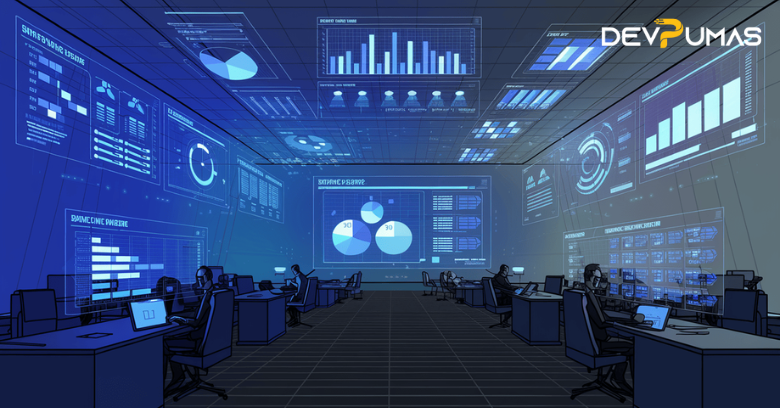Introduction: The Rise of Holographic Displays
The concept of holograms has long fascinated us, from futuristic sci-fi depictions to revolutionary real-world applications. Today, holographic displays are at the forefront of visual communication, promising immersive and lifelike interactions across industries. Leveraging advances in light-field technology, 3D projection, and augmented reality, holographic displays are transforming how we connect, collaborate, and experience digital content.
In this article, we explore the latest breakthroughs in holographic displays, their applications in gaming, meetings, and beyond, as well as their potential to redefine visual communication in the years to come.
1. What Are Holographic Displays?
Holographic displays are advanced visual technologies that project 3D images into space, allowing viewers to see lifelike, interactive visuals without needing special glasses. Unlike traditional 2D screens, holographic displays create a depth of field, making objects appear as though they exist in the physical world.
These displays rely on cutting-edge light manipulation techniques, such as diffraction and light-field projection, to create high-resolution 3D visuals that users can view from multiple angles.
2. How Holographic Displays Work
Holographic displays use several core technologies to produce realistic 3D images:
2.1 Light-Field Technology
Light-field displays project light rays in different directions, simulating how light interacts with objects in real life. This creates a natural 3D effect.
2.2 Diffractive Optics
Diffractive optics create highly detailed holograms by splitting light into various angles and intensities.
2.3 Spatial Light Modulators (SLMs)
SLMs control light waves to produce high-resolution holographic images, enabling dynamic, interactive visuals.
2.4 Projection Systems
Advanced projection systems combine lasers and micro-mirrors to cast 3D images into space, visible without the need for external hardware like headsets.
These technologies make holographic displays an accessible and intuitive medium for visual communication.
3. Applications of Holographic Displays
The applications of holographic displays span a wide range of industries, from business and gaming to healthcare and education.
3.1 Business Meetings and Collaboration
Holographic displays enable remote teams to collaborate in real-time as if they were in the same room. Life-size, 3D holograms of participants can be projected into conference rooms, fostering deeper engagement.
Example: Companies like ARHT Media and PORTL have developed holographic meeting systems that allow for remote holographic telepresence.
3.2 Gaming and Entertainment
In gaming, holographic displays provide immersive experiences by projecting 3D environments and characters into physical spaces. Players can interact with these holograms in real time, adding a new dimension to gameplay.
Example: Holographic tabletop games allow users to manipulate 3D objects using gesture controls, creating a truly interactive experience.
3.3 Education and Training
Holographic displays enhance learning by presenting complex concepts in 3D. For example:
- Science Classes: Visualize molecular structures or anatomy.
- Technical Training: Simulate machinery operations in engineering courses.
Educational institutions are beginning to adopt holographic displays to make learning more engaging and accessible.
3.4 Healthcare
In healthcare, holographic displays are revolutionizing diagnostics, surgery, and patient education:
- Surgeons use holograms to visualize organs and plan procedures.
- Patients can better understand medical conditions through 3D projections.
These applications improve accuracy and patient outcomes.
4. Technological Advances Driving Holographic Displays
Several technological breakthroughs have accelerated the development of holographic displays:
4.1 AI and Machine Learning
AI algorithms enhance hologram generation by optimizing light-field rendering and object tracking, making displays more realistic.
4.2 5G Connectivity
High-speed, low-latency 5G networks enable real-time transmission of holographic data, crucial for applications like live meetings and gaming.
4.3 Miniaturization of Hardware
Compact, portable holographic projectors are making the technology more accessible to businesses and consumers.
4.4 Augmented Reality (AR) Integration
Combining AR with holographic displays allows for interactive, context-aware experiences in education, retail, and beyond.
5. Challenges in Adopting Holographic Displays
Despite their potential, holographic displays face several adoption challenges:
5.1 High Costs
The production and deployment of holographic display systems remain expensive, limiting their adoption to larger enterprises and high-end markets.
5.2 Technical Limitations
- Resolution: Achieving lifelike resolutions is still challenging.
- Viewing Angles: Some displays have restricted angles, reducing immersion for larger audiences.
5.3 Scalability
Creating scalable holographic solutions for mass-market adoption requires further innovation in hardware and software.
5.4 Content Creation
Developing 3D holographic content is complex and requires specialized skills and tools.
6. The Future of Holographic Displays
The future of holographic displays holds exciting possibilities, driven by advancements in technology and increasing demand for immersive experiences:
6.1 Mainstream Adoption
As costs decrease and hardware becomes more compact, holographic displays will become commonplace in homes, offices, and public spaces.
6.2 Holographic Streaming
Real-time holographic streaming will become a standard for entertainment, remote meetings, and live events.
6.3 Consumer Devices
Smartphones and wearables equipped with holographic projection capabilities will make 3D visuals more accessible to consumers.
6.4 Sustainability
Energy-efficient holographic systems will emerge, reducing their environmental footprint and supporting green technology initiatives.
7. How Businesses Can Leverage Holographic Displays
7.1 Invest in Early Adoption
Companies can gain a competitive edge by adopting holographic displays for marketing, collaboration, and customer engagement.
7.2 Partner with Developers
Collaborating with holographic technology providers enables businesses to create customized solutions tailored to their needs.
7.3 Explore Training Applications
Businesses can use holographic displays to train employees in fields like medicine, manufacturing, and customer service.
7.4 Build Immersive Marketing Campaigns
Holograms can be used to create memorable, interactive marketing campaigns that capture consumer attention.
Wrapping It Up: Holographic Displays as the Future of Communication
Holographic displays are more than a technological breakthrough—they are a paradigm shift in how we interact with digital content and one another. From redefining remote meetings to transforming gaming and education, holographic technology is unlocking new possibilities for visual communication.
As hardware becomes more affordable and accessible, holographic displays are poised to become an integral part of everyday life. By investing in these innovations, businesses and individuals can embrace a future where technology seamlessly blends with reality, creating immersive and impactful experiences.



